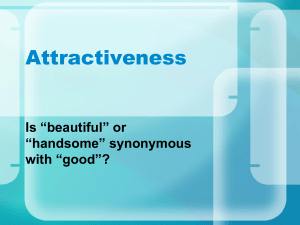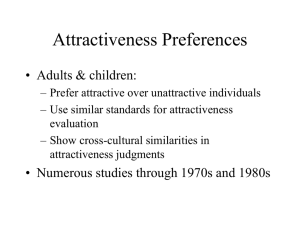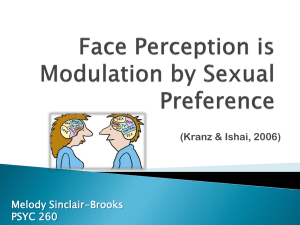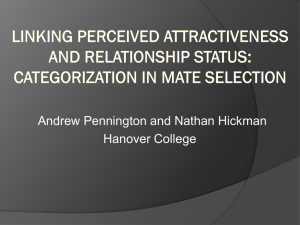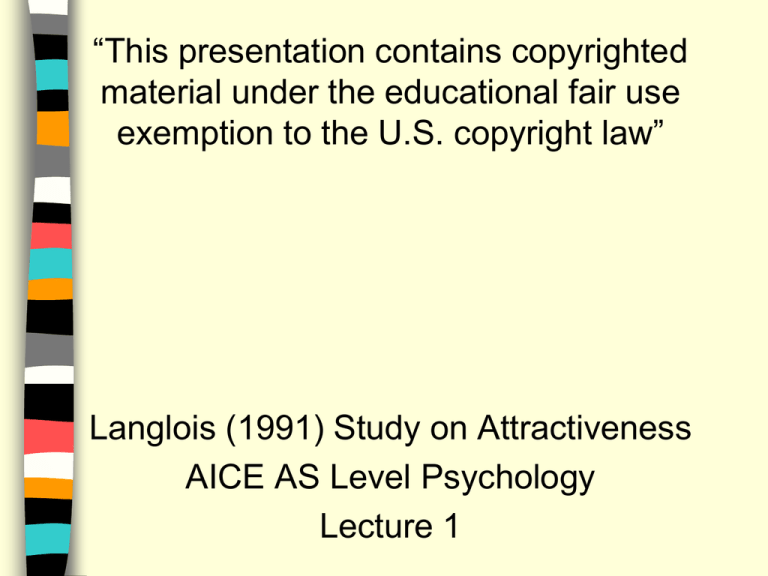
“This presentation contains copyrighted
material under the educational fair use
exemption to the U.S. copyright law”
Langlois (1991) Study on Attractiveness
AICE AS Level Psychology
Lecture 1
Facial Diversity and
Infant Preferences
for Attractive Faces
Langlois, J. H., Ritter, J. M.,
Roggman, L. A., & Vaughn, L.
S. (1991).
I. Attractiveness
Nature Vs. Nurture
A. Are our preferences due to
evolutionary programming (genetic)?
• 1. Study after study reveals that we have
a preference for symmetrical faces.
• 2. The implication is that faces that are
not symmetrical may reflect a
mutated/bad gene
.. “Beautiful faces and bodies worldwide are generally
ones that look youthful, healthy, symmetrical, "average"
in the sense that we prefer features– noses, legs,
physiques– that are neither too large nor too small”
David G. Myers in Psychology
Attractiveness
Nature
These images were created by
morphing together the features of
many women to come up with the
"average" face.
Attractiveness
Nurture?
B. Or are our preferences for
attractiveness culturally transmitted?
• 1. Some cultures prefer lengthened
necks, bound feet and painted skin
II. Theoretical Background
A. Previous studies
• 1. Previous studies by Langlois and
•
others indicated that babies had a
behavioral and visual preference for
attractive FEMALE faces
2. Other studies (Samuels and Ewy)
found the same for male faces
• 3. These studies refuted the generally
•
held belief that the concept of
attractiveness is transmitted over time by
culture
4. Previous studies had not considered
attractiveness across gender and race.
II. Study 1: Aim
A. To replicate their previous results
with adult female facial stimuli
B. To extend the results to male facial
stimuli
C. To investigate whether the manner
in which male and female faces are
presented influences infant
preferences
II. Study 1: Sample
A. 60-6 month old infants
• 1. Began with 110 infants.
• 2. Several were rejected for various
reasons including fussiness, computer
error, experimenter error and because the
mother’s saw the slides.
• 3. Of the 60 final participants
a. 53 of them were Caucasian, 5 Hispanic, 1
Black and 1 Asian
b. All were tested with in 3 weeks of turning 6
months.
c. 35 male 25 female
d. All from middle class homes
e. All were children at the Children’s
Research Lab at the University of Texas at
Austin
Cue 1: What type of sample is this?
Cue 2: List two strengths and two
weaknesses of this type of sample.
“This presentation contains copyrighted
material under the educational fair use
exemption to the U.S. copyright law”
Langlois (1991) Study on Attractiveness
AICE AS Level Psychology
Lecture 2
III. Study 1: Method
A. This was a laboratory
experiment
• 1. Each infant saw color slides of 16 adult
•
Caucasian women & 16 Caucasian adult
men
2. Half of the slides of each sex depicted
attractive faces, the other half unattractive
faces
III. Study 1: Method
• 3. Operational definition of attractive: The slides’
faces were rated for attractiveness by at least 40
undergraduate men & women using a 5-point
Likert-type scale (rating scale)
• 4.Final faces selected:
Facial expression, hair length, hair color were equally
distributed across attractiveness conditions
All male faces clean-shaven
Clothing cues masked
Faces were posed with neutral expressions
III. Study 1: Method
B. Procedures
• 1. Standard visual preference technique
• 2. Infant seated on parent's lap; parent wore
•
•
occluded glasses.
3. A light and a buzzing noise
4. A trial began when the infant first looked at
one of the slides
When the infant looked at the center of the screen, the
next pair of slides was displayed.
Each trial lasted for 10 s.
Screen brightness consistent throughout
III. Study 1: Method
• 5. Presentation Order
The stimuli were presented in two sets of 16 slides
Each set divided into 8 trial blocks of 2 slides each
Control for infant side biases
Slides paired so that infants viewed only pairs of women
or pairs of men
Alternating condition, the infants observed alternating
pairs of males and females.
Grouped condition, infants saw all the women's slides
together & all the men's slides together
Order of set presentation, order of slide pair presentation
within sets (within the constraints of the set), & order of
slide pairing randomized across subjects so that a
particular slide of an attractive face could be paired with
any slide of an unattractive face of the same sex
III. Study 1: Method
6. Infants given 5-10-min break after 8 trials to
lessen fatigue
C. Data Collection
1. Direction & duration of looks recorded on the
keyboard of a laboratory computer that
functioned as an event recorder
III. Study 1: Method
• 2. Using the televised image of the infant to
observe visual fixation ensured that the
experimenter could not see the displayed slides
& was therefore blind to the attractiveness level
of the slides the infant was observing
• 3. Reliability of the visual-fixation scoring
obtained by having each experimenter score
randomly selected videotaped sessions
periodically throughout data collection
III. Study 1: Method
D. IV & DV
• 1. IV =
Attractiveness score of the face
A second comparison was made based on the
attractiveness of the infant’s mother – but this
was not found to be a significant factor
• 2. DV
Length of gaze
Measured by raters viewing video tapes of the
infants.
Researchers could not see the attractiveness
of the face being gazed at to avoid bias
Each infant measured by multiple researchers
so that inter-rater reliability could be
established.
IV. Study 1: Results
A. Infants looked longer at the
attractive faces than the unattractive
faces
B. Infant preferences for attractive
faces were evident for both adult male
& adult female faces
C. Other factors examined
• 1. Condition of presentation was not
significant
• 2. Boys looked longer at male faces
• 3. Girls also preferred same sex faces but
•
the finding was not statistically significant
4. Mother’s attractiveness did not make a
difference
Cue3: Why did they institute these
controls?
Cue 4: Why did the parents wear
glasses that blocked their vision of the
stimuli?
Cue 5: Why test for the impact of
mother’s attractiveness?
“This presentation contains copyrighted
material under the educational fair use
exemption to the U.S. copyright law”
Langlois (1991) Study on Attractiveness
AICE AS Level Psychology
Lecture 3
V. Study 2: Aim
A. To extend the findings to
non-white faces
• 1. Infants were shown faces of Black
adult women. The faces were rated for
attractiveness by both Black and
Caucasian adult judges.
VI. Study 2 –
Sample/Methods
A. Sample
• 1. Began with 43 infants but 2 were
•
excluded for fussiness and 1 for
equipment failure
2. 40-6 month old infants
a. 15 boys 25 girls
b. 36 White, 2 Hispanic, 2 Black
B. Presentation
• 1. Black adult female faces
• 2. Rest of procedure same as study 1
VII. Study 2: Results
A. Infants looked longer at the
attractive faces than the unattractive
faces
B. Again mother’s attractiveness did
not make a difference
VIII. Study 3 –
Aim/Sample/Methods
A. Aim - To extend the findings to
infant faces
B. Sample
• 1. 39-6 month old infants
a. (37 white, 2 Hispanic)
b. 19 boys 20 girls
VIII. Study 3 –
Aim/Sample/Methods
2. Study began with 52 participants with
several excluded for various reasons
C. Methods
• 1. 3 month old baby faces rated for
•
attractiveness as before
2. Rest of procedure as in study 1
IX. Study 3: Results
Infants looked longer at the attractive
faces than the unattractive faces
X. Explanation and
Discussion
A. Why did the findings contradict
what most thought about cultural
transmission of standards of beauty?
Perhaps “ethnically diverse faces
possess both distinct and similar,
perhaps even universal, structural
features.”
X. Explanation and
Discussion
B. Maybe beauty is (in some part)
nature NOT nurture
C. Prototypical faces
• 1. It would seem beautiful faces are
prototypical: an original form serving
as a basis or standard for other forms
• 2. Why might prototypical faces be
evolutionarily adaptive?
Individuals closer to the mean might be less
likely to have genetic mutations?
• 3. An average face has mathematically
•
•
average trait values for a population
4. Faces that are high in averageness are
low in distinctiveness and are therefore
prototypical
5.Several theorists have proposed that
average traits reflect developmental
stability
XI. Strengths and
Weaknesses
Strengths
A.
• 1. Generalization:
a. tested on male faces
b. tested on different races
c. tested on different ages (babies faces
presented.)
• 2. Lab Experiment highly controlled:
a. parent wore glasses,
b. infants given breaks
c. inter-rater reliability
d. Raters could not see faces
e. Made infants focus prior to presenting
images
f. Attractive/unattractive randomized
g. Attractive/unattractive presented on
different sides
B. Weaknesses
• 1. Lacks ecological validity: real life
•
situation
2. Ethnocentric bias: too many white
babies, only black women
XII. Issues & Debates
A. Nature v. Nurture
• 1. Clearly attempts to assess the role of
•
nature vs. nurture
2. Used babies so they could narrow
focus on nature
B. Ethics:
• 1. Generally good
Mothers were there with children
Informed consent
RTW babies who were fussy were removed
from study to alleviate stress
care in taking care of babies (parental aspect)
Cue 6: What type of study was this?
Cue 7: What are 2 strengths and weaknesses of
this method?
Cue 8: What type of design? Strengths and
weaknesses of the design?
Cue 9: Does this study support nature or nurture
Cue 10: How is this an example of the
developmental perspective
Cue 11: Is this study useful? Why or why not?
Cue 12: To what extent do you think this study is
ethical? Explain your answer.

